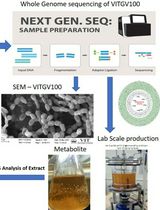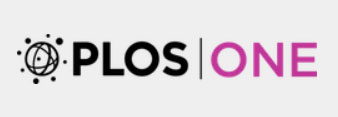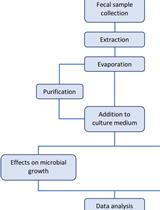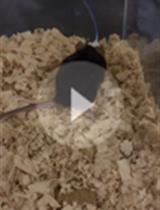- EN - English
- CN - 中文
Optimized Oxidative Stress Protocols for Low-microliter Volumes of Mammalian Plasma
可用于测定低微量哺乳动物血浆中氧化应激因子的优化实验方法
发布: 2019年05月05日第9卷第9期 DOI: 10.21769/BioProtoc.3221 浏览次数: 4592
评审: Pornima PhatakRAMESH KUDIRAAnonymous reviewer(s)

相关实验方案

番茄内生菌Streptomyces sp. VITGV100中吲哚类代谢产物的合成与提取分析
Veilumuthu Pattapulavar [...] John Godwin Christopher
2025年07月20日 1962 阅读
Abstract
Small blood volumes commonly obtained from small mammals during field studies are only sufficient for a single biochemical assay. In this study, we used blood collected from a population of wild eastern chipmunks (Tamias striatus) and developed modified methods to improve analytical selectivity and sensitivity required for measuring markers of oxidative stress using small blood volumes. Specifically, we proposed a modified malondialdehyde (MDA) analysis protocol by high performance liquid chromatography (HPLC) and also optimized both the uric acid independent ferric reducing antioxidant power (FRAP) and hypochlorous acid shock capacity (HASC) assays. We present methods in which a total volume of less than 60 μl of plasma is required to obtain a comprehensive portrait of an individual’s oxidative profile.
Keywords: High-performance liquid chromatography (高效液相层析)Background
Measuring markers of oxidative stress has become increasingly popular and useful for the evaluation of individual’s physiological status. Measuring multiple oxidative stress markers and estimating methodological precision usually requires large blood sample volumes, making it difficult for researchers to perform comprehensive analyses of oxidative stress profile of small wild animals. We present in-house assays optimized to yield the most selective analysis for each marker using the smallest blood volumes possible (Langille et al., 2018).
MDA is a product of lipid peroxidation that in recent years has been measured by HPLC (Nussey et al., 2009). We present an HPLC method employing UV detection that uses a low volume of plasma to obtain a sensitivity and detection range appropriate for oxidative stress studies.
The ferric reducing antioxidant power (FRAP) assay has been extensively used in various disciplines ranging from agronomy and nutrition (Carlsen et al., 2010; Di Silvestro et al., 2017) to ecological studies (Griffin and Bhagooli, 2004; Ruykys et al., 2012; Eikenaar et al., 2018). Antioxidants in the samples reduce the ferric-tripyridyltriazine (Fe3+-TPTZ) complex to ferrous tripyridyltriazine (Fe2+-TPTZ), producing a blue color. The coloration intensity is proportional to the reducing capacity of the mostly non-enzymatic antioxidants in the plasma, hence providing the overall antioxidant capacity. Uric acid has been shown to interfere with the result of this assay however, Duplancic et al. (2011) proposed removing the uric acid using uricase with larger volume sample. We optimized the amount of uricase and sample needed to successfully remove all uric acid from a smaller sample, therefore improving the efficiency and accuracy of the test.
The HASC assay is commonly referred to by its kit named OXY-Adsorbent TestTM from Diacron International (Grosseto, Italy). In this test, an excess of hypochlorous acid, a strong oxidant, is added and incubated with a plasma sample. The hypochlorous acid oxidizes any reduced components in the plasma, then a chromogenic dye is added to quantify the remaining hypochlorous acid. Although the test was already optimized for 10 µl, the relatively high cost of each plate made it difficult for researchers to utilize this kit in large studies. We reduced the required volume to 1 µl and provide an in-house protocol to prepare the reagents and execute the test.
Materials and Reagents
- Standard flat bottomed 96-well plates (Sarstedt AG & Co., catalog number: 82.1581)
- Screw cap 500 µl microcentrifuge tube (BioBasic, catalog number: TC132-SN)
- 300 μl microinsert HPLC vial (Chromatogaphic Specialties, catalog number: C73302101232)
- 1.5 ml microcentrifuge tubes (BioBasic, catalog number: BT620NS)
- 15 ml centrifuge tube (VWR, catalog number: 89401-568)
- 50 ml centrifuge tube (VWR, catalog number: 76176-956)
- Aluminum Foil (Fisher, catalog number: 01-213-101)
- Acetonitrile, HPLC grade (VWR, catalog number: CABDH83639.400)
- Water, HPLC grade (VWR, catalog number: CABDH23595.400)
- Trifluoroacetic acid, HPLC grade (VWR, catalog number: CATX1276-6)
- 2-thiobarbituric acid (EMD Millipore, catalog number: 108180)
- Malondialdehyde bis (diethylacetal) (4 °C, 12 months) (Sigma-Aldrich, catalog number: T9889)
- Butylated hydroxytoluene (Sigma-Aldrich, catalog number: B1378)
- Trichloroacetic acid 6.1 N (Sigma-Aldrich, catalog number: T0699)
- Uricase (-20 °C, 12 months) (Sigma-Aldrich, catalog number: U0880)
- Ferric Chloride Hexahydrate (BioBasic, catalog number: FD0201)
- Ferrous Sulfate (BioBasic, catalog number: FB0461)
- Sodium Acetate Trihydrate (BioBasic, catalog number: SB0481)
- Acetic Acid, Glacial (VWR, catalog number: CA71006-424)
- TPTZ (Sigma-Aldrich, catalog number: T1253)
- NPD (Sigma-Aldrich, catalog number: 193992)
- 12.5% Sodium Hypochlorite (store in the dark, 12 months) (VWR, catalog number: BDH7038-4L)
- Hydrochloric Acid (HCl) (VWR, catalog number: CA11020-884)
- Sulfuric Acid (VWR, catalog number: CA11024-170)
- Sodium Hydroxide (NaOH) (VWR, catalog number: BDH9292)
- Anhydrous Ethanol (Commercial Alcohols, catalog number: P016EAAN)
- 0.1 M butylated hydroxytoluene (BHT) solution (see Recipes)
- 15% trichloroacetic acid solution (see Recipes)
- 2 N NaOH solution (see Recipes)
- 2-thiobarbituric acid solution (see Recipes)
- 0.25 M HCl solution (see Recipes)
- Uricase stock solution (see Recipes)
- Uricase working solution (see Recipes)
- Acetate buffer solution (see Recipes)
- 400 mM stock HCl solution (see Recipes)
- 40 mM HCl solution (see Recipes)
- TPTZ solution (see Recipes)
- Ferric chloride solution (see Recipes)
- 30 mM Ferrous sulfate stock solution (see Recipes)
- FRAP reagent (see Recipes)
- NPD stock solution (see Recipes)
- 0.6 M Sulfuric acid solution (see Recipes)
- Oxidant solution (see Recipes)
Equipment
- 100 ml volumetric flask, class A (VWR, catalog number: 10124-072)
- 500 ml volumetric flask, class A (VWR, catalog number: 10545-998)
- 1 L volumetric flask, class A (VWR, catalog number: 10546-000)
- Amber bottles (VWR, catalog number: 89221-624)
- Ice bath (VWR, catalog number: 10146-190)
- Water bath (VWR, catalog number: 89501-464)
- Fume hood (VWR, catalog number: 89260-062)
- Magnetic stirrer (VWR, catalog number: 97042-634)
- Analytical balance (VWR, catalog number: 10205-026)
- iMark Filter absorbance microplate reader (Bio-Rad, catalog number: 1681135)
- 515 nm Filter for microplate reader (Bio-Rad, catalog number: 1681033)
Note: If a 515 nm filter is not available, an alternative filter in the range of 510-520 nm will suffice. - 1100 Series Binary pump (Agilent Technologies, model: G1312A)
- 1100 Series Autosampler (Agilent Technologies, model: G1313A)
- 1100 Series Column compartment (Agilent Technologies, model: G1316A)
- 1100 Series Variable wavelength detector (Agilent Technologies, model: G1315A)
- ODS2 250 x 4.6 mm 5 µm HPLC column (Waters Corp., catalog number: PSS831915)
- Vortex Mixer (VWR, catalog number: 10153-842)
- Shaking dry-block (Eppendorf, VWR, model: Thermomixer, catalog number: CA11028-280)
- Barnstead E-Pure water system (Barnstead, Thermo Fisher, model: E-Pure)
- Refrigerated Centrifuge (Eppendorf, model: 5418R)
- Micropipette set (Eppendorf, catalog number: 2231000601)
- Spectrophotometer (Thermo Fisher, model: Genesys10S)
- pH meter (VWR, catalog number: 89231-662)
- 4 °C refrigerator (VWR, catalog number: 89239-070)
- -20 °C freezer (VWR, catalog number: 10819-408)
- -80 °C freezer (VWR, catalog number: 10160-740)
Software
- OpenLab Chromatography Data System (Agilent Technologies, http://www.agilent.com/)
- Microplate Manager 6 (Bio-Rad Laboratories Canada Ltd., http://www.biorad.com/)
Procedure
文章信息
版权信息
© 2019 The Authors; exclusive licensee Bio-protocol LLC.
如何引用
Langille, E. A. (2019). Optimized Oxidative Stress Protocols for Low-microliter Volumes of Mammalian Plasma. Bio-protocol 9(9): e3221. DOI: 10.21769/BioProtoc.3221.
分类
生物化学 > 其它化合物 > 小分子
您对这篇实验方法有问题吗?
在此处发布您的问题,我们将邀请本文作者来回答。同时,我们会将您的问题发布到Bio-protocol Exchange,以便寻求社区成员的帮助。
提问指南
+ 问题描述
写下详细的问题描述,包括所有有助于他人回答您问题的信息(例如实验过程、条件和相关图像等)。
Share
Bluesky
X
Copy link











